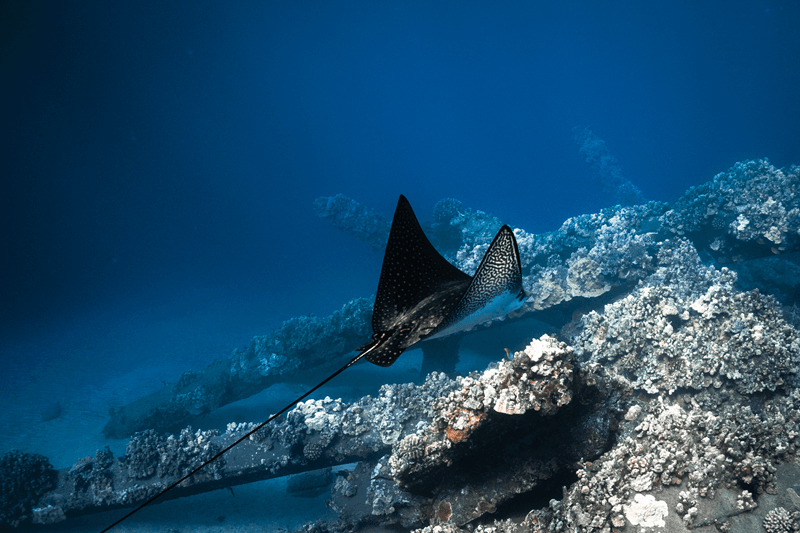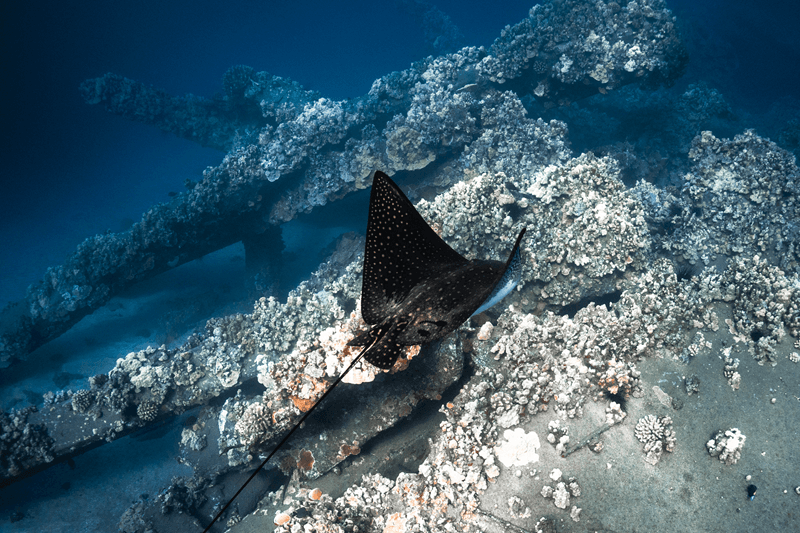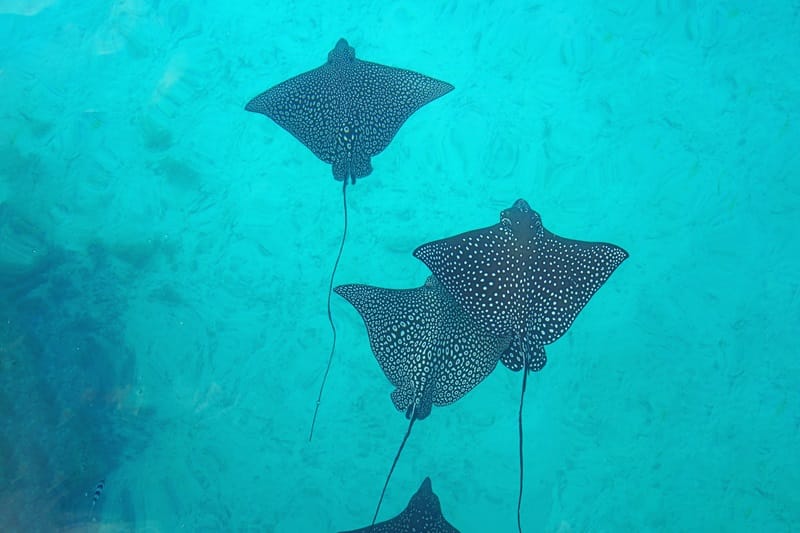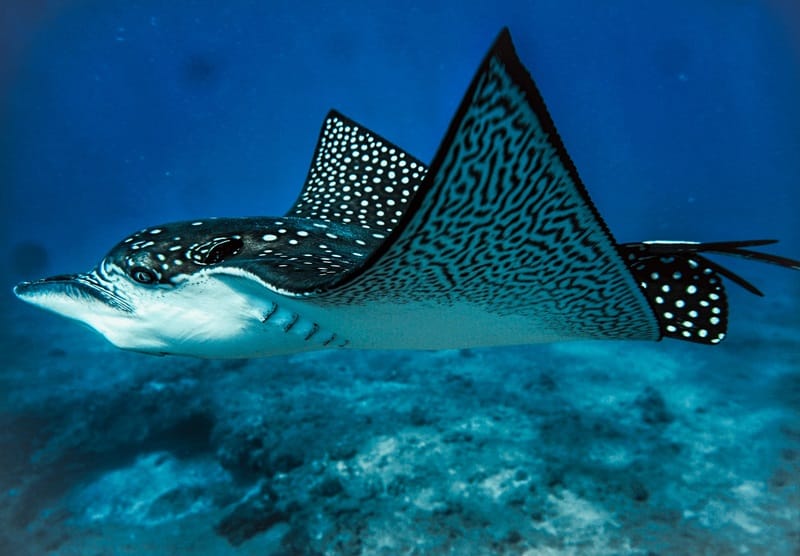Maui is renowned for its crystal-clear waters, vibrant coral reefs, and an impressive array of marine life. Among the many awe-inspiring creatures that dwell in these waters, few captivate snorkelers and divers quite like the spotted eagle ray. Known in Hawaiian as hihimanu, this magnificent ray appears to fly through the ocean with the ease and elegance of a soaring bird. If you find yourself visiting the Valley Isle and have the chance to plunge into Maui’s underwater realm, keep an eye out for these remarkable creatures.
Encountering a spotted eagle ray in Maui is an experience that imprints itself on your memory, a moment of pure, unadulterated awe. These aren’t just pretty faces in the ocean. Spotted eagle rays are fascinating creatures with unique adaptations, intriguing behaviors, and a vital role to play in the marine ecosystem. Let’s dive deeper into the world of the hihimanu and discover why they are such a celebrated sight in Maui’s waters.
An Introduction to the Spotted Eagle Ray
Hihimanu, which translates to “magnificent” or “elegant bird.” They earned this poetic name thanks to their wing-like pectoral fins that allow them to glide with an unmatched combination of grace and power beneath the ocean surface.
Although these rays are indeed fish, they differ from most bony fish because they have a cartilaginous skeleton, more akin to sharks than to creatures such as parrotfish or tangs. This composition not only helps them remain lightweight and flexible but also links them to other members of the ray and shark family, who share several unique adaptations such as electroreceptors and specialized teeth.
Physical Characteristics and Coloration
One of the first things you’ll notice about a spotted eagle ray is its striking coloration. Their dorsal—or top—surface is typically a dark, inky black or charcoal gray background adorned with eye-catching white spots. This dramatic pattern distinguishes them from other rays you might encounter in Hawaiian waters and also provides some camouflage against predators that might view them from above, such as certain species of sharks.
Flip the ray over, and you will see a vivid white underside. On each “wing,” a geometric pattern of black lines often appears against the brighter underbelly. Though you will need to observe them closely (perhaps while scuba diving or snorkeling), these intricate designs are breathtaking.
Spotted eagle rays possess large, angular “wings,” which are actually pectoral fins. Their wingspan can stretch to around six feet from tip to tip, making a close-up encounter an unforgettable experience. Despite their size, they frequently appear to flit and hover in the water like birds on an updraft.
Additionally, these rays have a long whip-like tail, which often carries one or more barbed spines at its base. This detail can lead to confusion with other, more common stingrays. In Hawaiʻi, however, there are three species that truly bear the “stingray” classification, sporting venomous spines further down along the tail. In contrast, the spines of the spotted eagle ray lie closer to its body. Although these barbs can cause excruciating pain when contacted directly, spotted eagle rays are typically shy in the presence of humans, choosing to swim away when approached.
Schnorcheln im Molokini-Krater
Experience the magic of Molokini Crater! Snorkel with vibrant fish and majestic sea turtles. Book your adventure today!
Where Do Spotted Eagle Rays Live?
They can be found throughout the Hawaiian Islands, including waters near Maui. They favor shallow coastal areas and reef environments, particularly if the water is clean, warm, and teeming with their preferred prey. The Hawaiian Archipelago, with its extensive coral systems and relatively stable ocean temperatures, offers a hospitable habitat.
In Maui, hihimanu are usually seen in areas where reef structure or sea beds provide opportunities to hunt for buried snacks (more on their diet in a moment). They occasionally venture into deeper waters, but they are more often spotted gliding near the coastline or popping into popular dive sites. Keep in mind that sightings are not guaranteed—they travel widely and can appear in large schools or cruise alone in small groups.
The Fascinating Senses
Much like sharks and other rays, spotted eagle rays are equipped with special electro-sensory organs known as the ampullae of Lorenzini. These sensory pores, located around the ray’s jaw and snout, allow them to detect electric fields produced by potential prey (and even sense the Earth’s magnetic field, aiding in navigation).
Think of the ampullae of Lorenzini as a built-in metal detector. When small crustaceans hide in the sand, the rays easily pinpoint and scoop them up thanks to the subtle electrical signals every living creature emits. In addition to electro-sensing, spotted eagle rays also possess a lateral line system—a line of receptors along each side of the body that detects changes in water motion. This helps them sense nearby fish, potential predators, and other movements or vibrations, allowing them to respond quickly and effectively to any threat or opportunity.
What’s on the Menu?
These rays are generally carnivorous, feeding on a variety of crustaceans and mollusks. They favor snails, shrimp, crabs, and sea urchins, all of which can often be found scuttling or burrowing in the sandy or rocky seafloor. Their specialized mouths reveal flat, hard teeth plates—imagine a built-in nutcracker—that can crush the hard shells of their prey. Once these shells are shattered, the rays spit out the fragmented pieces, then swallow the soft tissues inside.
Interestingly, male spotted eagle rays have teeth plates that are slightly more pointed than females. Researchers believe this distinction helps the male grip the female’s fin during mating. Because these rays often need a firm hold to align for reproduction, that subtle difference in their dental structure can play a significant role in their life cycle.
The Mating Ritual and Reproduction
Spotted eagle rays reach sexual maturity between four and six years of age. During mating, the male typically uses his more pointed teeth to latch onto the trailing edge of the female’s “wing,” securing himself briefly in place. The actual act of mating may last around a minute or so, but the lead-up can involve graceful swimming and occasional leaps out of the water.
Interestingly, spotted eagle rays display a form of reproduction known as ovoviviparity. Their embryos develop in the left uterus of the female, feeding on specialized “uterine milk” for nourishment rather than receiving a constant flow of nutrients through an umbilical cord. After a gestation period, a female will typically give birth to one to four pups. Each newborn ray measures somewhere between 10 to 20 inches across, its wings folded up like a bat’s. New mothers have been observed launching themselves completely out of the water, where they appear to release the pups in mid-air, effectively “birthing on the fly.”
Once in the water, pups can unfold their wings almost immediately and begin swimming. Being able to move right from birth is critical since sharks, most notably tiger sharks in Hawaiʻi, are a primary predator for spotted eagle rays—newborn rays need to swim fast or risk falling prey.
Spotted Eagle Rays vs. True Stingrays
Despite that menacing-looking whip tail, which does carry barbed spines, the spotted eagle ray is not classified as a true stingray in Hawaiʻi. In true Hawaiian stingrays, venomous spines line the tail much further down from the ray’s body. Hawaiian eagle rays pose little threat to humans except in the rare instance that one is touched or stepped on. Because these creatures usually keep their distance when approached by snorkelers or divers, injuries are exceedingly rare.
Still, it’s wise to practice respectful ocean etiquette. If you spot a spotted eagle ray while snorkeling, give it space to swim freely. Admire it from a comfortable distance rather than crowding or trying to touch it, thereby minimizing stress for the animal and ensuring your own safety.
Schnorcheln Maui
Discover Maui’s underwater wonders! Snorkel amidst vibrant coral reefs and encounter fascinating marine life. Book your Maui Snorkeling adventure today!
Where to Spot Eagle Rays in Maui
These rays can be found all throughout Maui, but here are a few of the more common spots:
Molokini-Krater
A popular snorkeling and dive destination, Molokini-Krater is situated a few miles off the coast of South Maui. This volcanic atoll is famous for its clear visibility—often exceeding 100 feet—making it a prime spot for underwater sightings. Spotted eagle rays sometimes cruise along the outer ledges or near the crater’s reef walls.
Molokini-Krater-Schnorcheltour
Embark on our daily Molokini-Krater-Schnorcheltour departing from Ma’alaea Harbor! This two-stop adventure (7 am-12 pm) takes you to the crater and the renowned Schildkrötenstadt Maui. Enjoy breakfast and lunch onboard, along with all the snorkeling gear you’ll need. Reserve your spot now and get ready to swim with vibrant tropical fish, graceful sea turtles, and possibly an eagle ray!
Turtle Town (Maluaka Beach)
Named for its resident green sea turtles, Turtle Town in the Makena area also sees occasional visits from spotted eagle rays. The calm waters and gentle slope of the sea floor make it a comfortable place for these rays to forage. Early mornings, when the sun is less intense, can be a particularly good time for an encounter. Book your spot today for our morning tour to Turtle Town Maui!
Olowalu Reef
Located along the West Maui coastline, Olowalu Reef is known for its expansive coral gardens and rich marine life. This shallow reef system offers a chance to observe spotted eagle rays gliding in search of food. The sandy areas between coral heads are prime feeding grounds for them as they probe the sand for crustaceans.
Kaʻanapali Beach and Black Rock
Kaʻanapali Beach is a bustling resort area, but early-morning snorkelers near Black Rock have been rewarded with sightings of spotted eagle rays. Black Rock’s deeper drop-offs offer a corridor where rays sometimes patrol.
Honolua-Bucht
Northwest of Kapalua, Honolua Bay is a scenic marine preserve known for healthy reefs and diverse sea life. On a calm day, you might spot one passing through in small groups.
Best Time and Conditions for Sightings
Spotted eagle rays don’t adhere to a strict seasonal schedule in Maui, but there can be periods where they appear more frequently. In general:
Early Mornings: Many marine creatures are more active in the morning when there is less boat traffic and human activity.
Calm Seas: When the water is calmer, visibility tends to be better, making it easier to spot gliding rays.
High Tides: Rays might move closer to shore to feed during higher tides, though this is not guaranteed.
Signing up for our guided snorkel tours can also improve your chances of an encounter. We know the rays’ most frequent haunts and can optimize your outing around daily conditions. But remember, these are wild animals—no matter how prepared you are, sightings can never be completely guaranteed.
Threats and Conservation
Spotted eagle rays, while not as critically endangered as some marine species, still face a range of threats:
Predation by Sharks: Tiger sharks in particular are natural predators.
Fishing Pressure: Eagle rays occasionally get targeted for their oil or fishmeal, though they are not widely prized for their meat.
Bycatch and Entanglement: They can become accidental catches in nets or fishing lines, which can lead to serious injury or death.
Habitat Destruction: Coastal development, pollution, and coral reef damage can negatively affect their feeding grounds.
As with many marine species, balancing tourism and development with conservation is crucial. Spotted eagle rays benefit from the establishment of marine protected areas, fishing regulations, and responsible tourism practices that help maintain healthy fish populations and reef systems. By choosing our sustainable snorkeling tours and participating in local cleanups, visitors to Maui can play a small but meaningful role in the preservation of these remarkable rays.
The Cultural Significance of Hihimanu
For centuries, Hawaiians have revered marine life not just as a resource but as part of a larger cultural tapestry. In Hawaiian tradition, the spotted eagle ray—hihimanu—embodies grace and beauty. Its name, translating to “magnificent” or “elegant bird,” speaks to the awe these rays inspire when seen gliding through Hawaiian waters. Many locals and visitors alike feel a sense of reverence encountering these animals, viewing them as reminders of the ocean’s extraordinary diversity.
Some Hawaiian myths and legends feature rays and other sea creatures as aumakua (family guardians). While not all families might have the spotted eagle ray as an aumakua, the broader concept imbues Hawaiian marine life with deep respect and spiritual significance, influencing a sense of kuleana—one’s responsibility—to protect these animals and their environment.
Tips for a Respectful Encounter
Maintain a Comfortable Distance: Approaching them too closely can cause it stress, leading the ray to flee or alter its behavior.
Do Not Touch: Although rays are docile, touching them can injure their sensitive skin or cause a defensive reaction.
Avoid Chasing: If you try to pursue or corner a ray, it can become agitated. Allow them space to move naturally in their habitat.
Minimize Splashing: Abrupt movements or loud splashes may startle marine animals.
Use Reef-Safe Sunscreen: Chemicals in conventional sunscreens can damage coral reefs—the base of the ray’s ecosystem. Opt for mineral-based, reef-safe alternatives.
Part of the excitement of seeing a spotted eagle ray is the sense that you’re a guest in its domain. The calmer and more respectful you are, the better your chances of a meaningful observation.
Photographing Spotted Eagle Rays
If you’re keen on capturing a photo or video of the ray, consider these suggestions:
Slow, Steady Movements: Minimize your own motion in the water to reduce disturbance.
Buoyancy Control: If you’re scuba diving, good buoyancy control prevents you from colliding with the seabed or coral, which can scare the rays away.
Natural Light: If snorkeling in shallow areas, the sunlight filtering through the surface often provides beautiful highlights on a ray’s spotted pattern.
Respectful Distance: Use zoom if possible rather than moving too close. Beyond ensuring the ray’s comfort, these practices can lead to clearer and more impressive shots.
Bringing the Experience Home
One of the gifts of snorkeling or diving in Maui is the unforgettable memory of encountering marine life in its natural habitat. Many visitors describe their first sight of a spotted eagle ray as a sense of “time standing still,” overwhelmed by the fluid motion and the grace of these creatures. While it’s natural to want to share this moment on social media or among friends, consider also sharing conservation messages and your own sense of responsibility toward the ocean. Through storytelling and advocacy, each traveler can help inspire others to respect and protect Hawaii’s marine environments.
If you want to delve deeper, you might explore local conservation efforts or follow reef protection organizations in Hawaiʻi. By staying informed, you can contribute to the well-being of spotted eagle rays whether you’re on the island or at home.
Abschließende Gedanken
Maui’s allure stretches far beyond its sunny beaches and lush mountains. Beneath the waves lies a world brimming with color, life, and wonder—none more mesmerizing than the spotted eagle ray. From its dazzling spotted pattern to its curious feeding and reproductive habits, the spotted eagle ray represents the elegance and mystery of Hawaii’s marine realm. Its very name in Hawaiian, hihimanu, reflects the reverence these islands hold for a creature that seems to both dance and soar beneath the sea.
A journey to Maui becomes richer when you learn about the creatures inhabiting its waters. By seeking out responsibly run tours, respecting marine life guidelines, and appreciating the cultural significance of these animals, you not only enhance your own experience but also help ensure that future generations can marvel at the same spectacular sights.
Whether you’re an avid diver, a first-time snorkeler, or simply a curious explorer, keep your eyes open for the telltale white spots and gently flapping wings of these rays. If you’re fortunate enough to spot a spotted eagle ray in the wild, pause to savor that magical moment. In that instant, you become part of a centuries-long story of harmony between the islands’ people, their traditions, and the mesmerizing creatures of Hawaii’s seas.
‘Aʻohe hana nui ke alu ʻia—“No task is too big when done together.” By learning, sharing, and cultivating respect for Maui’s marine life, we take part in a collective effort to preserve these oceans and the beautiful hihimanu that glide through them. May your encounter with a spotted eagle ray be as awe-inspiring as legends describe, and may you carry that awe with you, wherever you go, as a constant reminder of the ocean’s fragile magnificence. We hope to see you on our snorkeling tours!
Maui Schnorcheltouren
Dive into Maui’s crystal-clear waters and explore its vibrant coral reefs teeming with marine life. Our Maui Snorkeling Tours offer unforgettable experiences for all skill levels. Book your underwater adventure today and create memories that will last a lifetime!




